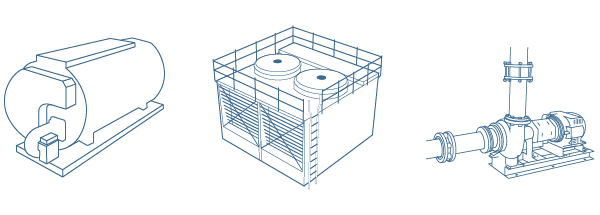Locations and Best Practices


What is the purpose of an Injection Quill?

Chemically treating steam boilers offers some safety considerations that need to be addressed. The chemical injection equipment must be able to withstand elevated temperatures and pressures. Typical chemical metering pumps are packaged with an injection quill and other components that are constructed of plastic such as PVC, EPDM or PTFE. These plastics are not designed to withstand the strenuous conditions of a steam boiler and upgraded materials are required. Stainless steel (SS) quills solve this problem.
A SS quill can withstand the added heat burden of a steam boiler allowing the quill to act as a safe intermediary between the plastic chemical metering pump and the steam boiler itself.
How do I know if I need to replace an Injection Quill?

SS injection quills are like any other mechanical item: they will eventually fail. Injection quills include a check or one way valve that prevents process water from pushing backwards up the chemical injection tubing. The most common failure is that the quill’s check valve gets stuck either open, or more often, closed, disrupting the chemical flow to the process.
One way to identify injection quill failure, is if chemical fails to properly inject into the process. To determine if the injection quill is at fault, each point of potential failure must be investigated. The chemical metering pump has a foot valve, the pump head contains multiple valves, and may also hold a plastic injector interfacing with the stainless-steel injection quill. Each of these items needs to be checked for failure along with the quill to ensure the point of failure is properly identified.
Debris can become lodged in the process side of the injector, disrupting flow of chemical and creating chemical delivery failure. This is especially likely if the quill is injecting to a steam header. Quills injecting into steam headers must be oriented correctly to mitigate this issue.
What are the different types of Injection Quills?


For safety purposes, Jaytech recommends that all steam boilers be outfitted with some sort of stainless-steel injection system for your boiler chemicals. Depending on the number of chemicals in your treatment program, a simple quill may suffice. There are also multi-plex quills available where 2, 3 or even 4 chemicals can be fed.
Where should I place my injection quill?

Chemical injection in steam systems can be done in several places. Historically, chemicals were fed directly to the boiler. Different industries have since developed different trains of thought regarding this issue, especially the placement of condensate additives.
Due to restrictions in certain industries, the safest place to inject ALL chemistries is into the system’s de-aerator storage tank (or feed water tank). Multi-plex quills become valuable in these circumstances because 3-4 chemicals can be independently fed into one SS quill system.
Some boiler operators prefer to feed condensate additives directly to the steam system. When this is done, the chemical is injected straight to the main steam header. In some instances, it may be necessary to set up one or more additional satellite feed points at strategic locations downstream.
Ask an Expert at Jaytech to review your system & Injection Quills
Jaytech Expert Takeaways & Tips:

> If you’re feeding chemicals into a steam boiler, make sure your injection setup is as strong as your treatment program. <
1. Injection Quills Must Match System Conditions
> Standard plastic components (PVC, PTFE, EPDM) used in chemical feed systems are not suitable for steam boiler conditions.
> Stainless steel (SS) injection quills are required to withstand the heat and pressure of these systems.
2. SS Quills Provide Critical Protection
>A stainless-steel quill safely connects the plastic metering pump to the boiler by handling the thermal burden, preventing material degradation and system failure.
3. Check Valve Failure is Common
> Most quill failures stem from the check valve sticking closed, preventing chemical feed.
> Diagnosing a failure requires checking the entire chemical feed line, not just the quill (e.g., foot valve, pump head, injector tip).
4. System Steam Header Injection Requires Extra Care
> Debris buildup in the quill tip—especially when injecting into steam headers—can block chemical delivery.
> Proper orientation of the quill is key to maintaining flow and avoiding clogs.
5. Different Quill Types for Different Applications
> Use multiplex SS quills to safely inject multiple chemicals through one port, especially when feeding to a de-aerator or feedwater tank.
> Some setups may still require satellite injection points for direct steam header injection.

Consultation with a Jaytech CWT

If you see any noncompliant injection points, immediately upgrade appropriately. This is especially important for steam system safety and chemical integrity.
Inspect chemical injection systems regularly. Add this to your list of items to monitor for loss of feed pressure, inconsistent chemical delivery, or check valve sticking.
Use multiplex quills when injecting multiple chemicals. This reduces the number of ports and simplifies installation, especially in de-aerators.
Verify proper installation orientation—especially for steam header quills. You want to do this to prevent debris blockage and ensure reliable dosing.
Train operators on identifying injection system failures. Help them differentiate between pump, tubing, or quill-related failures during troubleshooting. Jaytech offers multiple trainings, or Jaytech Universities to help you get your team fully trained on all system maintenance best practices.

